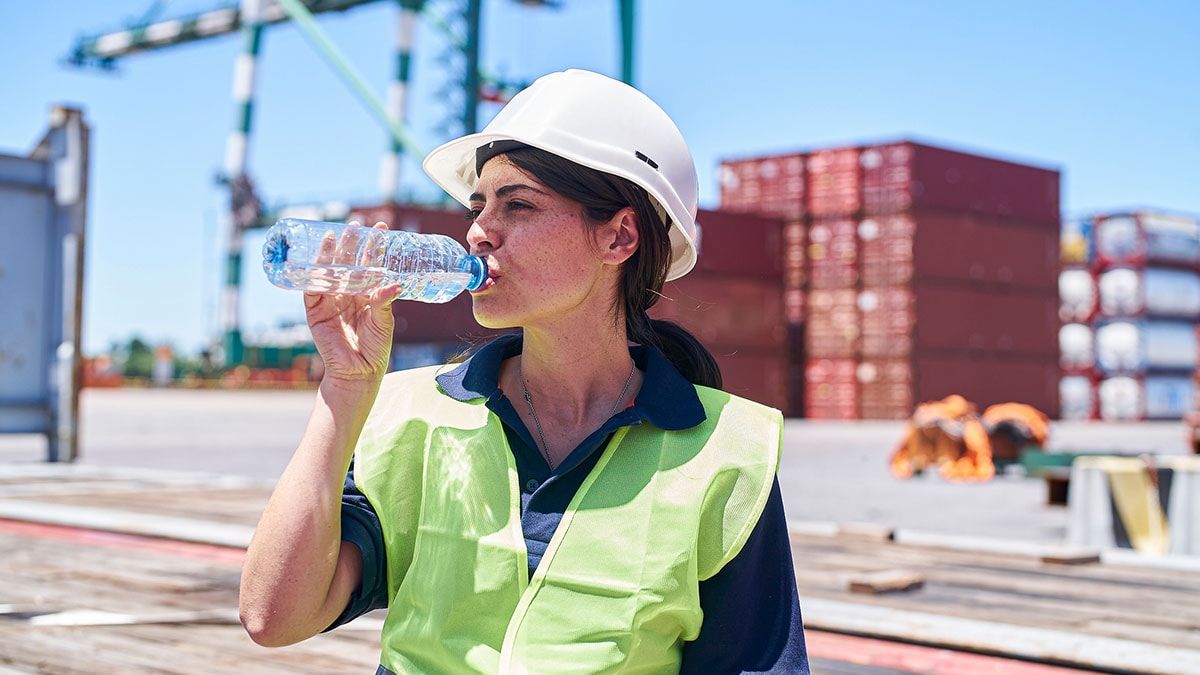What to know
- This page has basic recommendations that apply to different workplaces. If heat stress is a hazard at your workplace, consult a safety and health professional. Review the full recommendations in the NIOSH Criteria for a Recommended Standard: Occupational Exposure to Heat and Hot Environments.

Controls
Employers should reduce workplace heat stress by using engineering and administrative (work practice) controls. An engineering control could be a change to the design of the workplace that reduces exposure to heat. Administrative controls are changes to tasks or schedules to reduce heat stress.
Engineering controls might include those that:
- Increase air velocity.
- Use reflective or heat-absorbing shielding or barriers.
- Reduce steam leaks, wet floors, or humidity.
Work practice recommendations include the following:
- Limit time in the heat and/or increase recovery time spent in a cool area.
- Reduce the metabolic (physical difficult) demands of the job.
- Use tools intended to minimize manual strain.
- Increase the number of workers per task.
- Train supervisors and workers about heat stress.
- Use a buddy system where workers observe each other for signs of heat-related illnesses.
- Require workers to conduct self-monitoring and create a work group (i.e. workers, a qualified healthcare provider, and a safety manager) to make decisions on self-monitoring options and standard operating procedures.
- Provide adequate amounts of cool, potable water near the work area and encourage workers to drink often.
- Use a heat alert program whenever the weather service forecasts a heat wave.
- Institute a heat acclimatization plan and encourage increased physical fitness.
Training
Train workers before hot outdoor work begins. Tailor the training to worksite conditions.
Employers should provide a heat stress training program for all workers and supervisors about the following:
- Recognition of the signs ans symptoms of heat-related illnesses and administration of first aid.
- Causes of heat-related illnesses and steps to reduce the risk. These include drinking enough water and monitoring the color and amount of urine output.
- Proper care and use of heat-protective clothing and equipment and the added heat load caused by exertion, clothing, and personal protective equipment.
- Effects of other factors (drugs, alcohol, obesity, etc.) on tolerance to occupational heat stress.
- The importance of acclimatizatuion.
- The importance of immediately reporting any symptoms or signs of heat-related illness in themselves or in coworkers to the supervisor.
- Procedures for responding to symptoms of possible heat-related illness and for contacting emergency medical services.
Supervisors should also be trained on the following:
- Implementing appropriate acclimatization.
- What procedures to follow when a worker has symptoms of heat-related illness, including emergency response procedures.
- Monitoring weather reports.
- Responding to hot weather advisories.
- Monitoring and encouraging adequate fluid intake and rest breaks.
Acclimatization
Acclimatization is the result of beneficial physiological adaptations (e.g., increased sweating efficiency, etc.) that occur after gradual increased exposure to a hot environment. Employers should ensure that workers are acclimatized before they work in a hot environment.
- Gradually increase workers' times in hot conditions over 7 to 14 days.
- For new workers, the schedule should be:
- No more than 20% of the usual duration of work in the heat on day 1.
- No more than 20% increase on each additional day
- No more than 20% of the usual duration of work in the heat on day 1.
- For workers with previous experience, the schedule should be:
- No more than 50% of the usual duration of work i n the heat on day 1.
- No more than 60% of the usual duration of work in the heat on day 2.
- No more than 80% of the usual duration of work in the heat on day 3.
- No more than 100% of the usual duration of work in the heat on day 4.
- No more than 50% of the usual duration of work i n the heat on day 1.
- Closely supervise new employees for the first 14 days or until they are fully acclimatized.
- Workers who are not physically fit need more time to fully acclimatize.
- Acclimatization can be maintained for a few days of non-heat exposure.
- Taking breaks in air conditioning will not affect acclimatization.
Hydration
Employers should provide the means for appropriate hydration of workers.
- Water should be portable, <15°C (59°F), and made accessible near the work area.
- Estimate how much water will be needed and decide who will get and check on water supplies.
- Provide individual drinking cups for each worker.
- Encourage workers to hydrate themselves.
Workers should drink an appropriate amount to stay hydrated.
- For moderate activities in the heat that last less than 2 hours, drink 1 cup (8 oz.) of water every 15–20 minutes.
- If sweating lasts for several hours, drink sports drinks containing balanced electrolytes.
- Avoid alcohol and drinks with high caffeine or sugar.
- Generally, fluid intake should not exceed 6 cups per hour.
Rest breaks
Employers should ensure and encourage workers to take appropriate rest breaks to cool down and hydrate.
- Permit rest and water breaks when a worker feels heat discomfort.
- Modify work/rest periods to give the body a chance to get rid of excess heat.
- Assign new and unacclimatized workers lighter work and longer, more frequent rest periods.
- Shorten work periods and increase rest periods:
- As temperature, humidity, and sunshine increase.
- When there is no air movement.
- If protective clothing or equipment is worn.
- For heavier work.
- As temperature, humidity, and sunshine increase.
